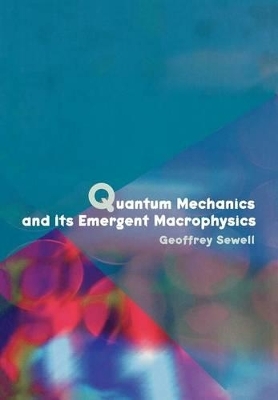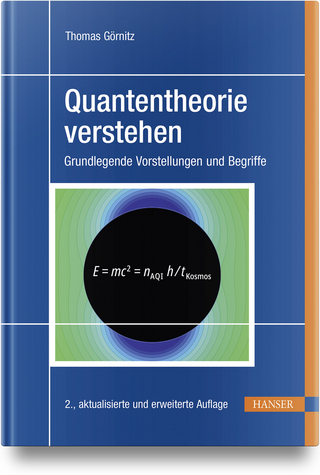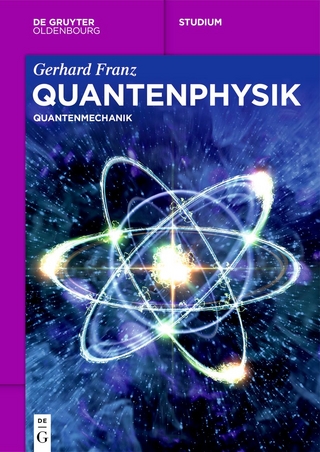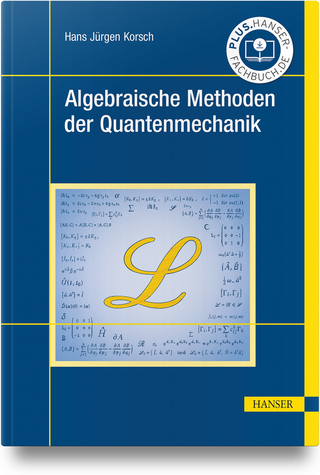
Quantum Mechanics and Its Emergent Macrophysics
Princeton University Press (Verlag)
978-0-691-05832-0 (ISBN)
The quantum theory of macroscopic systems is a vast, ever-developing area of science that serves to relate the properties of complex physical objects to those of their constituent particles. Its essential challenge is that of finding the conceptual structures needed for the description of the various states of organization of many-particle quantum systems. In this book, Geoffrey Sewell provides a new approach to the subject, based on a "macrostatistical mechanics," which contrasts sharply with the standard microscopic treatments of many-body problems. Sewell begins by presenting the operator algebraic framework for the theory. He then undertakes a macrostatistical treatment of both equilibrium and nonequilibrium thermodynamics, which yields a major new characterization of a complete set of thermodynamic variables and a nonlinear generalization of the Onsager theory. The remainder of the book focuses on ordered and chaotic structures that arise in some key areas of condensed matter physics.
This includes a general derivation of superconductive electrodynamics from the assumptions of off-diagonal long-range order, gauge covariance, and thermodynamic stability, which avoids the enormous complications of the microscopic treatments. Sewell also unveils a theoretical framework for phase transitions far from thermal equilibrium. Throughout, the mathematics is kept clear without sacrificing rigor. Representing a coherent approach to the vast problem of the emergence of macroscopic phenomena from quantum mechanics, this well-written book is addressed to physicists, mathematicians, and other scientists interested in quantum theory, statistical physics, thermodynamics, and general questions of order and chaos.
Geoffrey Sewell is Professor of Mathematical Physics at Queen Mary, University of London. His previous book, "Quantum Theory of Collective Phenomena", is a classic in the field.
Preface ix Notation xi Part I. The Algebraic Quantum Mechanical Framework and the Description of Order, Disorder and Irreversibility in Macroscopic Systems: Prospectus 1 Chapter 1. Introductory Discussion of Quantum Macrophysics 3 Chapter 2. The Generalised Quantum Mechanical Framework 7 2.1. Observables, States, Dynamics 8 2.2. Finite Quantum Systems 8 2.2.1. Uniqueness of the Representation 8 2.2.2. The Generic Model 10 2.2.3. The Algebraic Picture 13 2.3. Infinite Systems: Inequivalent Representations 15 2.3.1. The Representation o-(+) 15 2.3.2. The Representation o(-) 17 2.3.3. Inequivalence of o:(+-) 17 2.3.4. Other Inequivalent Representations 18 2.4. Operator Algebraic Interlude 18 2.4.1. Algebras: Basic Definitions and Properties 18 2.4.2. States and Representations 21 2.4.3. Automorphisms and Antiautomorphisms 24 2.4.4. Tensor Products 26 2.4.5. Quantum Dynamical Systems 27 2.4.6. Derivations of *-Algebras and Generators of Dynamical Groups 28 2.5. Algebraic Formulation of Infinite Systems 29 2.5.1. The General Scheme 29 2.5.2. Construction of the Lattice Model 32 2.5.3. Construction of the Continuum Model 34 2.6. The Physical Picture 39 2.6.1. Normal Folia as Local Modifications of Single States 39 2.6.2. Space-translationally Invariant States 39 2.6.3. Primary States have Short Range Correlations 40 2.6.4. Decay of Time Correlations and Irreversibility 41 2.6.5. Global Macroscopic Observables 42 2.6.6. Consideration of Pure Phases 44 2.6.7. Fluctuations and Mesoscopic Observables 45 2.7. Open Systems 46 2.8. Concluding Remarks 47 Appendix A: filbert Spaces 48 Chapter 3. On Symmetry, Entropy and Order 57 3.1. Symmetry Groups 57 3.2. Entropy 58 3.2.1. Classical Preliminaries 58 3.2.2. Finite Quantum Systems 59 3.2.3. Infinite Systems 62 3.2.4. On Entropy and Disorder 64 3.3. Order and Coherence 65 3.3.1 Order and Symmetry 65 3.3.2. Coherence 68 3.3.3. Long Range Correlations in G-invariant Mixtures of Ordered Phases 69 3.3.4 Superfluidity and Off-diagonal Long Range Order 70 3.3.5. On Entropy and Order 72 3.4. Further Discussion of Order and Disorder 72 Chapter 4. Reversibility, Irreversibilty and Macroscopic Causality 75 4.1. Microscopic Reversibility 76 4.1.1. Finite Systems 76 4.1.2. Infinite Systems 78 4.2. From Systems to Subsystems: Completely Positive Maps, Quantum Dynamical Semigroups and Conditional Expectations 79 4.2.1. Complete Positivity 79 4.2.2. Quantum Dynamical Semigroups 81 4.2.3. Conditional Expectations 82 4.3. Induced Dynamical Subsystems 83 4.4. Irreversibility 83 4.4.1. Irreversibility, Mixing and Markovian Dynamics 83 4.5. Note on Classical Macroscopic Casuality 86 Appendix A: Example of a Positive Map that is not Completely Posistive 88 Appendix B. Simple Model of Irrversibilty and Mixing 89 Appendix C. Simple Model of Irreversibilty and Macroscopic Casuality 94 C.1. The Model 94 C.2. Equations of Motion 98 C.3. Macroscopic Description of B 100 C.4. The Phenomenological Law 102 C.5. The Fluctuation Process 103 Part II. From Quantum Statistics to Equilibrium and Nonequilibrium Thermodynamics: Prospectus 107 Chapter 5. Thermal Equilibrium States and Phases 109 5.1. Introduction 109 5.2. Finite Systems 11l 5.2.1. Equilibrium, Linear Response Theory and the KMS Conditions 111 5.2.2. Equilibrium and Thermodynamical Stability 112 5.2.3. Resume 112 5.3. Infinite Systems 113 5.3.1. The KMS Conditions 113 5.3.2. Thermodynamical Stability Conditions 118 5.4. Equilibrium and Metastable States 123 5.4.1. Equilibrium States 123 5.4.2. Metastable States 124 5.5. Further Discussion 125 Chapter 6. Equilibrium Thermodynamics and Phase Structure 127 6.1. Introduction 127 6.2. Preliminaries on Convexity 131 6.3. Thermodynamic States as Tangents to the Reduced Pressure Function 135 6.4. Quantum Statistical Basis of Thermodynamics 136 6.5. An Extended Thermodynamics with Order Parameters 142 6.6. Concluding Remarks on the Paucity of Thermodynamical Variables 144 Appendix A: Proofs of Propositions 6.4.1 and 6.4.2 145 Appendix B: Functionals q as Space Averages of Locally Conserved Quantum Fields 146 Chapter 7. Macrostatistics and Nonequilibrium Thermodynamics 149 7.1. Introduction 149 7.2. The Quantum Field q(x) 153 7.3. The Macroscopic Model, M 155 7.4. Relationship between the Classical Field q and the Quantum Field q 158 7.5. The Model M(flunt) 161 7.6. The Linear Regime: Macroscopic Equilibrium Conditions and the Onsager Relations 164 7.7. The Nonlinear Regime: Local Equilibrium and Generalized Onsager Relations 165 7.8. Further Considerations: Towards a Generalization of the Theory to Galilean Continuum Mechanics 168 Appendix A: Tempered Distributions 170 Appendix B: Classical Stochastic Processes and the Construction of M(flunt) as a Classical Markov Field 176 B.1. Algebraic Description of Classical Stochastic Processes 176 B.2. Classical Gaussian Fields 178 B.3. Proof of Propositions 7.5.1 and 7.5.2 183 Appendix C: Equilibrium Correlations and The Static Two-Point Function 183 C.1. The Truncated Static Two-Point Function 184 C.2. Quantum Statistical Formulation of s"(q) 186 C.3. Formulation of n" via Perturbations of po 187 C.4. Proof of Propositions C.3.1 and C.3.2 for Lattice Systems with Finite Range Interactions 192 C.5. Pure Crystalline Phases 195 Part III. Superconductive Electrodynamics as a Consequence of Off-diagonal Long Range Order, Gauge Covariance and Thermodynamical Stability: Prospectus 197 ,p> Chapter 8. Brief Historical Survey of Theories of Superconductivity 199 Chapter 9. Off-diagonal Long Range Order and Superconductive Electrodynamics 211 9.1. Introduction 211 9.2. The General Model 213 9.3. ODLRO versus Magnetic Induction 218 9.4. Statistical Thermodynamics of the Model and the Meissner Effect 221 9.4.1 The Equilibrium States 221 9.4.2 Thermodynamical Potentials 222 9.5. Flux Quantisation 226 9.6. Metastability of Supercurrents and Superselection Rules 229 9.7. Note on Type II Superconductors 234 9.8. Concluding Remarks 236 Appendix A: Vector Potentials Representing Magnetic Fields with Compact Support 236 Part IV. Ordered and Chaotic Structures Far from Equilibrium: Prospectus 239 Chapter 10. Schematic Approach to a Theory of Nonequlibrium Phase Transitions, Order and Chaos 241 Chapter 11. Laser Model as a Paradigm of Nonequilibrium Phase Structures 247 11.1. Introduction 247 11.2. The Model 248 11.3. The Macroscopic Dynamics 256 11.4. The Dynamical Phase Transitions 260 11.5. The Microscopic Dynamics 264 11.6. A Nonequilibrium Maximum Entropy Principle 269 11.7. Concluding Remarks 271 Appendix A: Proof of Lemma 11.5.2 and Proposition 11.5.4 271 References 275 Index 287
| Erscheint lt. Verlag | 18.8.2002 |
|---|---|
| Zusatzinfo | 9 line illus. |
| Verlagsort | New Jersey |
| Sprache | englisch |
| Maße | 152 x 235 mm |
| Gewicht | 567 g |
| Themenwelt | Naturwissenschaften ► Physik / Astronomie ► Quantenphysik |
| ISBN-10 | 0-691-05832-6 / 0691058326 |
| ISBN-13 | 978-0-691-05832-0 / 9780691058320 |
| Zustand | Neuware |
| Haben Sie eine Frage zum Produkt? |
aus dem Bereich


